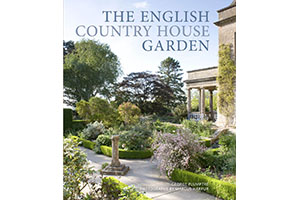The English Country House Garden When one thinks of the quintessentia
 When one thinks of the quintessentially English garden, the gardens of country houses immediately come to mind. Having spent what seems like a lifetime visiting them, enjoying wonderful vistas and immersing myself in their culture and particular ambience, you can imagine my joy at seeing George Plumptre’s latest book ‘The English Country House Garden’.
When one thinks of the quintessentially English garden, the gardens of country houses immediately come to mind. Having spent what seems like a lifetime visiting them, enjoying wonderful vistas and immersing myself in their culture and particular ambience, you can imagine my joy at seeing George Plumptre’s latest book ‘The English Country House Garden’.
This beautiful coffee table book is not just a compilation of 25 English gardens – although enough in themselves to promote one’s interest – it has been carefully crafted to illustrate the captivating partnerships of planting and garden design as well as bringing together gardens, houses and landscapes with people and history. In doing so the author illustrates how they create that special atmosphere, combined with a visual beauty, that touches the visitor to become so special in the memory.
The author writes in the introduction that the purpose of the book is to “complete the jigsaw that is the English country house garden so as to bring together all the contributing strands and show a picture that is more than just a compilation of the gardens included.” I think he succeeds in this very well. Across five chapters he weaves a rich and vibrant story.
First he sets the scene for country house gardens assuming lustrous fame with the three ‘essentials’ or role models of Hidcote, Sissinghurst and Great Dixter. The author examines why they have achieved pre-eminent reputations for more than a century. He follows this in the second chapter with five gardens to illustrate the sweep of history from Elizabethan Montacute to the 18th century landscape at Rousham. High Victorian at Tyntesfield, the Arts & Crafts at Rodmarton , and Folly Farm where an Edwardian masterpiece has been revived for the 21st century.
By now I was eagerly anticipating the third chapter which covers the ‘country house garden ideal’ and how a select group of gardens evoke this. Here I felt completely in my comfort zone because I could at once find resonance with Broughton Castle, Oxfordshire, whose gardens evoke that atmosphere of nostalgia and romanticism.
It is not always the planting or the garden layout which evokes that special interaction with the senses, it is the feeling of the relationship between the owner, their home and their garden, which gives a uniquely personal quality to a garden. So in this chapter in addition to Broughton Castle we are treated to Goodnestone Park, Kent; Kiftsgate Court, Gloucestershire; Trebah, Cornwall; Cothay Manor, Somerset; Helmingham Hall, Suffolk and Spencers, Essex.
I was pleased that gardens which are particularly ‘personal creations’ are also included. Here the emphasis is on the input of one person, or several generations of one family, to the creation of the garden.
So in the fourth chapter we find Charleston, East Sussex – where members of the Bloomsbury Group gardened in bohemian tranquility; Exbury, Hampshire – where Lionel de Rothschild created an unrivalled rhododendron garden; Thorp Perrow, North Yorkshire, Felley Priory, Nottinghamshire; and Lullingstone Castle, Kent.
I was particularly pleased to see the inclusion of Lullingstone where Tom Hart Dyke has created his World Garden, against what at times seemed impossible odds.
The fifth chapter looks at contemporary designers revealing where modern masters excel. In the introduction to this chapter the author remarks that Christopher Woodward, director of the Garden Museum in London, describes the first decade of the 21st century as the most splendid of great garden making since the Edwardian age.
The work of Piet Oudolf and Tom Stuart-Smith, Dan Pearson and the partnerships of Alan Gray and Graham Robeson, are featured here as well as Julian and Isobel Bannerman. North Yorkshire’s Scampston Hall, Seend Manor, Wiltshire; East Ruston Old Vicarage, Norfolk; Broughton Grange, Oxfordshire and the Old Rectory, Naunton, Gloucestershire, are included.
The book is lavishly and beautifully illustrated by Marcus Harpur, who has perfectly caught that special atmosphere in each garden featured. There are some stunning photographs perfectly complementing the text, bringing each garden alive to enable the reader to gain something of the special atmosphere of each garden.
There is also a very full select Bibliography and contact information (including website details) for each garden featured, something that authors of similar books can sometimes omit.
George Plumptre is Chief Executive of the National Gardens Scheme and the author of numerous books on garden history, design and horticulture, including Royal Gardens, The Garden Makers and Heritage Gardens. He is a regular contributor to Country Life and is also the author of The Country House Guide.
Marcus Harpur has been photographing and writing about gardens around the UK for the past twenty years. A contributing photographer to numerous books and principal photographer on How to Garden and The Winter Garden, he is a frequent contributor to Country Life, House and Garden and Gardens Illustrated.
‘The English Country House Garden’ will certainly stir up all those lingering feelings of nostalgia you have ever felt when walking around these iconic gardens. I found it both informative, stimulating and strangely somehow unsettling, because it stirred in me the urge to get out once more and revisit these wonderful places which are so uniquely English. It is one book which has definitely earned its place on my coffee table.
‘The English Country House Garden’ by George Plumptre, is published in hardback by Frances Lincoln at £25.00 – www.franceslincoln.com

